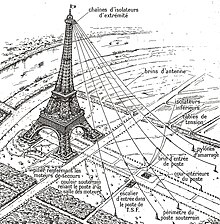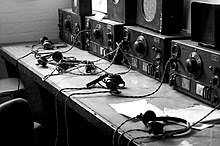Radio listening station



A radio listening station (also: radio listening position , listening point or listening station ; English station Listening , station radio intercept or intercept station wireless , short W / T station for wireless telegraphy station ) is used for military reconnaissance , in particular the communications intelligence (also referred to as signal Intelligence SIGINT) by "Interception" of radio transmissions . Unlike the original interception of an ( acoustic ) call , radio listening stations serve the use of wireless technology so over radio waves wirelessly transmitted information listen. For this purpose, highly sensitive radio receivers and suitable receiving antennas (picture) are used.
First World War
After Heinrich Hertz (1857-1894) was the first to succeed in generating electromagnetic waves in the ultra-short wave range in 1886 , and Guglielmo Marconi (1874-1937) was able to increase the range of his radio transmissions to hundreds of kilometers around 1900, radio technology was used in the first World War I (1914–1918), for example for communication within the German Army , the Imperial Russian Army - with fatal consequences in the Battle of Tannenberg (1914) - and on air radio . Conversely, France was already using the Eiffel Tower, which was closed to the public during the first year of the war, as a radio eavesdropping center (picture) . There, encrypted radio messages from the German western front were intercepted, the message content of which could be deciphered . This includes the Radiogramme de la Victoire ( German "Funkspruch des Sieges" ).
Second World War
In the twenty years between the end of the First and the beginning of the Second World War , radio technology had developed considerably and was now used extensively by all warring parties. This made radio detection and evaluation all the more important, which was also operated from all sides. The encrypted German communications ( Enigma , Lorenz etc.), which was intercepted by British radio eavesdropping stations around the world, was of vital importance to the war effort. For this purpose, the British used dozens of so-called Government Communications Wireless Stations (GCWS) , or Y Stations for short , which were not only set up in Great Britain for this purpose . The Wehrmacht also had comparable, albeit less effective, facilities in the form of the General's Intelligence Service ( Army ) and the B-Dienst (observation service ) of the Navy .
Cold War
With the approach of the Cold War , modern radio eavesdropping stations established themselves on both sides of the Iron Curtain, especially in divided Germany . Up until 1989, for example, there were two powerful monitoring systems on the summit of the Brocken, which lies directly on the inner-German border . One belonged to the Soviet military secret service GRU and was thus also the westernmost outpost of the Soviet Union , the other was subordinate to the main department III (radio reconnaissance, radio defense) of the Ministry for State Security (Stasi) of the GDR . The objects had the cover names "Yenisei" and "Urian", the latter also popularly known as the " Stasi mosque ". After 1989, a much larger wiretapping complex was planned on the Brocken, which was no longer implemented due to the fall of the Wall and the peaceful revolution in the GDR .
The so-called " listening station " is a building in Berlin-Mitte that was used by the Stasi to listen to the American embassy on the opposite side of the street.
Modern
The superpowers and their allies in particular still operate a wide-ranging network of eavesdropping stations around the world. One of the most famous is Echelon , which is operated by the intelligence services of the United States , United Kingdom , Canada , Australia, and New Zealand . Another is the Swiss onyx eavesdropping system (picture) .
Stationary radio eavesdropping stations in Germany are, for example, the BND branch offices in Bad Aibling and Gablingen . In England , RAF Menwith Hill should be mentioned (picture) . In addition, there are mobile radio eavesdropping stations such as radio test vehicles , reconnaissance ships or special reconnaissance aircraft for telecommunications reconnaissance.
literature
- Wilhelm Flicke: The Beginnings of Radio Intercept in World War I. www.nsa.gov (PDF; 550 kB; English)
- David Kahn : The Naval Intercept Station at Bainbridge Island, Washington. Cryptologia , 38: 244-247, 2014, doi: 10.1080 / 01611194.2014.915677
- Kenneth Macksey: The Searchers - Radio Intercept in Two World Wars. Cassell Military Paperbacks, London 2004, ISBN 0-304-36651-X
Web links
- The "Stasi Mosque" on the Brocken (photo)
- Radio eavesdropping devices in the Crypto Museum (English)
Individual evidence
- ↑ Menwith Hill eavesdropping base undergoes massive expansion in The Guardian, March 1, 2012, accessed April 30, 2019.
- ^ Royal Navy W / T Station at Southwold, October 24, 1944 (English), accessed April 30, 2019.
- ↑ Heinrich Hertz's original apparatus in the Deutsches Museum , accessed on April 29, 2019.
- ^ Wilhelm Flicke: The Beginnings of Radio Intercept in World War I. www.nsa.gov (PDF; 550 kB; English), accessed on April 29, 2019.
- ↑ Object URIAN - Brocken listening station , accessed on April 30, 2019.
- ↑ Central German landmarks: "How the Brocken became a fortress", from February 5, 2013, 8:45 pm broadcast by mdr .
